| Author |
Message |
|
Harry J. Fletcher
|
 Posted: Tue 09 Mar, 2010 9:03 pm Post subject: Spartan Lakonian Sword Posted: Tue 09 Mar, 2010 9:03 pm Post subject: Spartan Lakonian Sword |
 |
|
The Spartan sword evokes questions because of its shortness and there are many quotes from antiquity given regarding this; however, there are practical reasons for the shortness of this sword. Until the end of the Peloponesian wars the Hoplite was The infantryman and the way of fighting wars in Greece. The Lakadaimonians clung to this way of fighting even though they could not defeat Athens with a Hoplite army alone. Nevertheless, the short sword was adopted for use in the crush of bodies, armor, terror, sweat, fear, involuntary defecation and urination, blood, dust and limited vision. All a Hoptlite knew in the front rank was that he had to keep stabbing with his spear until it broke or the spear head bent and then he used the spear butt until it was unserviceable. This stabbing also was two way because spears were coming at the hoplite over the top of enemy shields as he and his neighbors were stabbing over the tops of their shields. If a hoplite was wounded, killed, or simply slipped he went under thousands of feet pushing back and forth and was trampled to death if still alive. The idea was to hold your ranks and push into the enemy's front ranks causing it to collapse and those behind to panic and start running away until the whole phalanx was broken and then the real slaughter began as men were killed trying to get away.
A long sword was of little use for slashing in this close crush of bodies and shields, so as the spear sought to penetrate the armor of the other hoplites, his neck, his groin, or even his armpit, so too would a short sword be useful in the same way for reaching over or under the shield to stab the groin or over it to stab the neck or even the armpit of an outstreached arm seeking to spear him.
I have two replicas of the Spartan Lakonian sword, one made by Scorpion Archery and Bow and the other made by Windlass.
The The Scorpion Lakonian has a blade length of 14.5 inches with an overall length of 19.75 inches and weight is 2 lbs. 15 oz. This is a really beefy sword with a modern scabbard I had made.
The Windlass version of the Spartan Lakonian has a blade length of 14.5 inches and an overall length of 19.5 inches but the total weight is only 1 lbs 15 oz.
The measurements and weights were done by myself so may differ from advertised by the manufacturers.
 Attachment: 201.91 KB Attachment: 201.91 KB
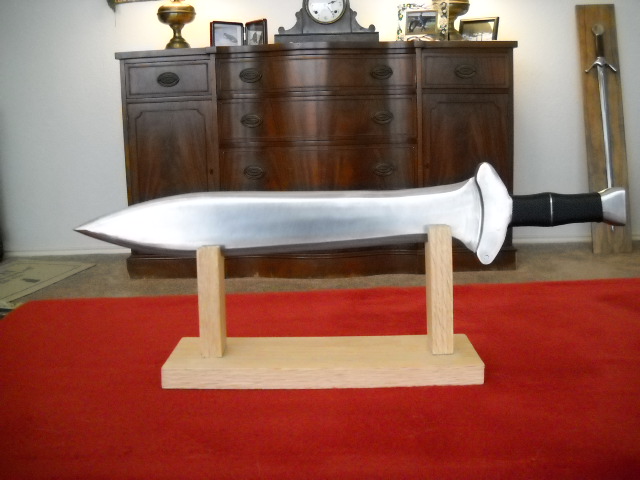
 Attachment: 203.7 KB Attachment: 203.7 KB
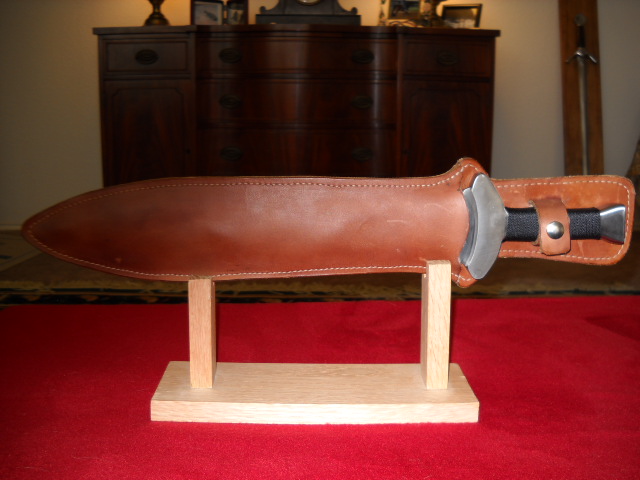
 Attachment: 204.46 KB Attachment: 204.46 KB
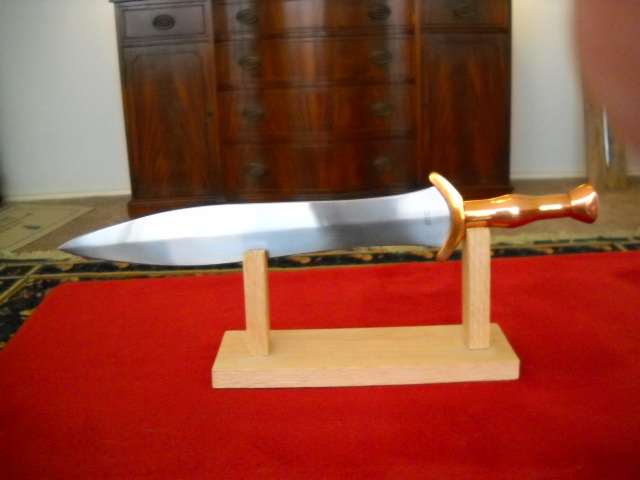
 Attachment: 201.66 KB Attachment: 201.66 KB
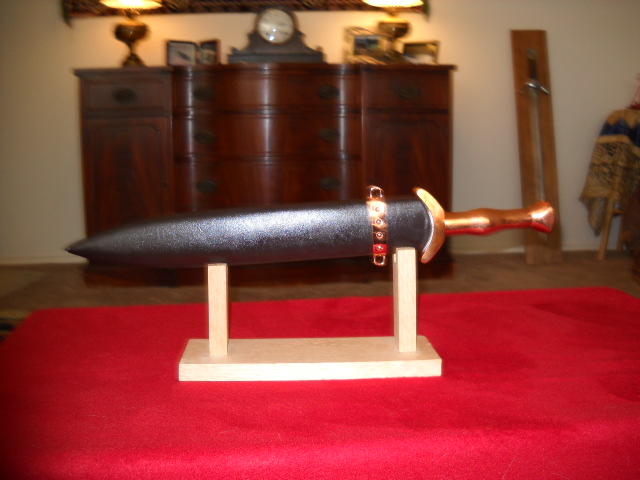
 Attachment: 202.21 KB Attachment: 202.21 KB
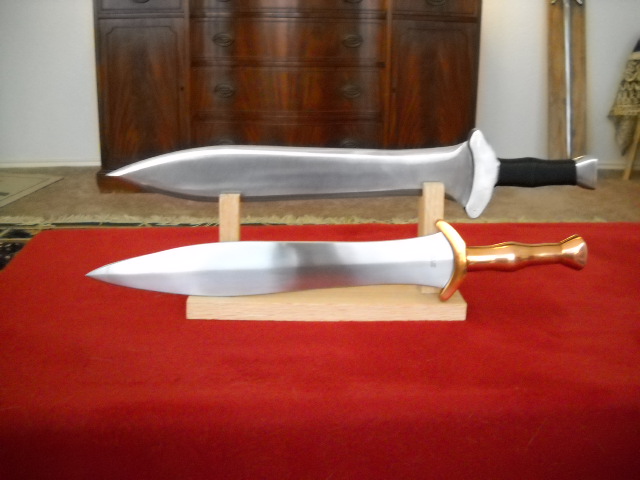
To Study The Edge of History
Last edited by Harry J. Fletcher on Wed 10 Mar, 2010 1:58 pm; edited 2 times in total
|
|
  |
 |
Stuart Thompson

Location: Walton-on-the-Naze Joined: 15 Feb 2010
Posts: 118
|
 Posted: Wed 10 Mar, 2010 12:39 am Post subject: Posted: Wed 10 Mar, 2010 12:39 am Post subject: |
 |
|
Were they used in a simlar way to the Gladius? I always assumed so because of the size and the Hoplite tactic(s) which is near enough your standard shield wall. Would their shields overlap?
Would trying to stab/cut under a shield leave you open? With a long sword (Especially in many Saxon/Viking warrior graves) wounds to the legs show the knee was cut (from behind?) leaving them crippled and to bleed to death..so really, if in this crush of bodies would it be possible to leave yourself open to an attack or like you said trampled between both sides?
Looking forward to those pic's.

|
|
  |
 |
|
Harry J. Fletcher
|
 Posted: Wed 10 Mar, 2010 2:16 pm Post subject: Roman shield vs Hoplite shield use Posted: Wed 10 Mar, 2010 2:16 pm Post subject: Roman shield vs Hoplite shield use |
 |
|
Although not familiar with the Roman infantryman tactics per se what I do know is that the Roman shield covered more of the Roman soldiers body and so did not need to be interlocked in Hoplite fashion. The legionary could push and stab and even manoeuver somewhat in the front rank. Whatever move his opponent made simply opened them up for the Roman sword thrust.
Hoplite tactics on the other hand were predicated on the interlocking of shields and pushing as a unit while stabbing with spears which sometimes could pierce body armor or helmets or even shields. It was shoulder to shoulder with one's neighbor close beside and his shield provided protection to your right side which caused the inevitable drift to the right of the phalanx. The necessitated the placing of the Phalanx commander and more experienced hoplite on the right to stop this drift. Also, the right of one phalanx would flank the right of the opposing phalanx while the opposite was true of the opposing side. Sometimes a hoplite was pushed into the front ranks of the enemy phalanx and found himself surrounded or else as the enemy phalanx front ranks started to break melees broke out as the rear ranks disintegrated. Afterall, not much could be seen from the rear ranks because of the dust and if panic set in the rear would just collapse.
I am just guessing but with the round shields of the Vikings, I assume the left leg was forward slightly which could expose it to a slashing blow of a sword but this is only a guess on my part.  
Regards,
Harry
To Study The Edge of History
|
|
  |
 |
|
Gregory J. Liebau
Location: Dinuba, CA Joined: 27 Nov 2004
Posts: 669
|
 Posted: Wed 10 Mar, 2010 3:58 pm Post subject: Posted: Wed 10 Mar, 2010 3:58 pm Post subject: |
 |
|
If my knowledge serves me correctly, the shape of these reproduction weapons is based solely on one example of a miniature cast sword, no? Looking through Warriors of Ancient Greece by Nicholas Sekunda, the 32.3 cm bronze model with a blade in this "leaf" shape was discovered in Crete. It has become a popular model for low-end reproductions. The typical fifth and fourth century Xiphos blades were tapered outward from a point just beyond the hilt, rather than centrally - like a Celtic leaf blade or the later Roman Mainz style gladii. Popular belief has also led to these shorter blades being the style used by the Spartans, but I am not sure if there is much artistic evidence to support the shape of these blades as being akin to this bronze model. The size of the blade, which is much smaller, is certainly likely because there is evidence to suggest that xiphos blades shortened in the 4th century considerably, but the shape is a bit weird methinks!
In Greece and Rome at War Peter Connolly provides citation for two extant xiphos blades. One, coming from a grave in Campovalano, is dated to approximately 500 BC (p. 63, fig. 7). It is shown below (taken from a public Photobucket account). The blade of this weapon is about 24" in length, according to John Warry in Warfare in the Classical World (p. 35).

The second is from Veria in Macedonia, and is a 4th century blade. The proportions are similar, but the blade is much smaller (p. 78, fig. 1). It is the lower sword in this image from this site.

From these examples, high-end custom reproductions such as those made by Manning Imperial of Australia probably much more realistically mimic the appropriate shape of the popular short xiphos of the 4th century. For example, this one.

Hope this information helps a bit concerning the historical shape of these blades, which I would call into question concerning the reproductions you've posted above.
-Gregory
My Flickr Galleries - Travel, Nature & Things
|
|
  |
 |
|
Gregory J. Liebau
Location: Dinuba, CA Joined: 27 Nov 2004
Posts: 669
|
 Posted: Wed 10 Mar, 2010 4:02 pm Post subject: Posted: Wed 10 Mar, 2010 4:02 pm Post subject: |
 |
|
| Quote: | | Also, the right of one phalanx would flank the right of the opposing phalanx while the opposite was true of the opposing side. |
This is actually not correct, although I think you may have just mis-worded it (as it sounds like you understand the concept). The right of a phalanx would flank the opposing army's left side as they engaged each other. The stronger troops were positioned on the right to oppose the enemy's left flank in hopes of achieving quick victory on that side of the field because of the mechanics of hoplite warfare and the motion of the phalanx, as you correctly described.
The Theban general Epaminondas was one of the first to place his elite troops on the left flank of his army, and thus crushed the Spartan right and killed the Spartan king at an engagement in the mid-4th century BC. This commotion caused a string of events that led to the new phalanx warfare that developed during the Macedonian wars.
-Gregory
My Flickr Galleries - Travel, Nature & Things
|
|
  |
 |
|
Harry J. Fletcher
|
 Posted: Wed 10 Mar, 2010 4:59 pm Post subject: Sparton Lakonian Posted: Wed 10 Mar, 2010 4:59 pm Post subject: Sparton Lakonian |
 |
|
Hi Gregory,
These are two swords among many used by the Greek Hoplite and one was the Xiphos which you have shown. The shorter sword is very nice indeed and I would like to know the dimensions especially the length of the blade for the shorter one. Also there was the falcutta another type of sword popular at one time with the Greeks and even popular with the Romans as well. As written by Nick Sekunda in his book The Spartan Army, Oprey Publishing; on page 31 there is a picture of Lakonian short sword. "...no short example of the Lakonian short sword has survived..." he goes on to say "... that a bronze model of a sword purchased in Crete in 1898 may well reproduce the shape. At 32.2cm it is slightly larger than life size and made of solid bronze...made for a slightly larger-than-life statue of a warrior..." I have attached a picture from the book showing this sword.
You are right in saying that the best men were placed to the right of the phalanx to give a hopefully quick victory over the less able men of the opposing phalanx. Perhaps, I didn't state this properly but there were times when the right simply outflanked the the opposing phalanx's left simply due to drift to the right.
Regards,
Harry
 Attachment: 202.52 KB Attachment: 202.52 KB
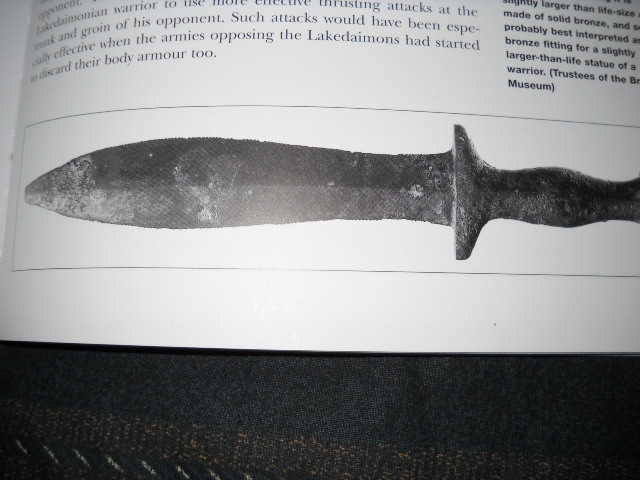
To Study The Edge of History
Last edited by Harry J. Fletcher on Wed 10 Mar, 2010 5:04 pm; edited 1 time in total
|
|
  |
 |
|
Gregory J. Liebau
Location: Dinuba, CA Joined: 27 Nov 2004
Posts: 669
|
 Posted: Wed 10 Mar, 2010 5:03 pm Post subject: Posted: Wed 10 Mar, 2010 5:03 pm Post subject: |
 |
|
Hello Harry,
The image you posted is the same one that I mentioned from Nick Sekunda's other Osprey title. I gave the dimensions and such in my first post! I find it unreasonable, personally, to assume that a small bronze sword that was most likely created for votive purposes and found on the island of Crete would reproduce a Spartan style of weapon. This is very shaky evidence to go by, when we have real examples and decent depictions of blade shapes on pottery, etc... That show xiphos blades all the way into the 4th century were actually shaped differently than this non-functional piece that Nick brings to light.
-Gregory
My Flickr Galleries - Travel, Nature & Things
|
|
  |
 |
|
Harry J. Fletcher
|
 Posted: Wed 10 Mar, 2010 5:12 pm Post subject: Posted: Wed 10 Mar, 2010 5:12 pm Post subject: |
 |
|
Hi Gregory,
Sorry for the oversight, but other people might be interested in seeing the example for themselves. I think we can all agree that the blade was short and obviously stout for stabbing. Since no specimens exist it is anyone's guess but you make a good argument indeed. Why not just shorten the blade of an existing sword? The Spartans were practical and cheapskates to boot, so why not. All I have to go on is what I have read.
Why not write a treatise on this for those of us interested in arms of this era as I am sure there is a lot of interest and room for debate.
Regards,
Harry
To Study The Edge of History
|
|
  |
 |
|
Gregory J. Liebau
Location: Dinuba, CA Joined: 27 Nov 2004
Posts: 669
|
 Posted: Wed 10 Mar, 2010 6:20 pm Post subject: Posted: Wed 10 Mar, 2010 6:20 pm Post subject: |
 |
|
Hello Harry,
Thank you for taking the time to respond! I want to note that I am not the type of naysayer who simply dismisses the possibility that this leaf blade is an example of a real fighting weapon. But, from an archaeological and historical perspective, the evidence for such a style of weapon is much less thorough than for the use of the wide-tipped, tapered blade style in the examples I cited. When we have two actual specimens to look at (I'm sure there must be more than two existing xiphos, where are all of the pictures and citations!?) and numerous small pottery images that do not invoke a leaf shape for xiphos blades during the fifth or fourth centuries, it just seems less conclusive to use leaf bladed reproductions as worthy representations of what the Lakonians really may have used in battle.
With regards to the short blades, the second example I posted, which is probably dated some 50-75 years after the Peloponnesian Wars (ca. 431-404 BC) is probably what I would estimate is a good example of a Lakonian blade of the 5th century. I am not suggesting the Spartans merely cut apart older blades to make them shorter, although that's certainly a possibility. Rather, I am suggesting that based on the knowledge we do have on xiphos evolution, taking my first example and then second side-by-side, that the blades maintained the same shape as they were crafted further in the future but were made shorter and shorter to assist in the style of sword play that was most efficient in the phalanx.
So, my argument is merely one that I find it most reasonable to use what solid evidence we have to recreate the short xiphos of the Spartans, rather than conjecture based on a single votive bronze piece from a nearby island. I believe that if we, as collectors or reenactors, did so more often, it would lead to public understanding of historicity that is more or less in the ballpark, and lead to less speculation and fanciful/wrong impressions. That's the historian in me arguing. Honestly, I think the leaf blades are sexy and if there was more than a scrap of evidence for later xiphos blades being shaped that way, I'd be a happy camper too!
-Gregory
My Flickr Galleries - Travel, Nature & Things
|
|
  |
 |
|
Harry J. Fletcher
|
 Posted: Wed 10 Mar, 2010 7:53 pm Post subject: Grave Steles evidence verify Spartan Blade shape Posted: Wed 10 Mar, 2010 7:53 pm Post subject: Grave Steles evidence verify Spartan Blade shape |
 |
|
Hi Greg,
There two pictures of grave steles (grave stones) in Mr. Sekunda's book, one on page 6 which shows the grave stele of an Athenian, Stratokles, being killed by a hoplite wearing a pylos helmet and using a short leaf shaped sword at the end the 5th centruy. Another grave stele on page 16 shows a hoplite on the ground who has lost his shield, is wearing a pylos helmet and is using a short leaf shaped sword to defend himself as an Athenian hoplite stands astride of him in the act of spearing him which dates to the late 5th century. He has been identified as an Lakedaimonian. I might add that Sparta did not allow grave steles except for those killed in battle. Here we have two grave steles with depictions of swords consistent with the sword pictured on page 31 of Mr. Sekunda's book. Only the Spartans to my knowledge used this this type of sword which was remarked upon extensively in the Hellenic world. Spartans were wearing the pylos helmet during the Pelopenisian war witness Spacteria when the Spartans on that island were overwhelmed by missile fire from troops of the Athenians and surrendered something unheard of until then. When finally ransomed during the Peace of Nicia they remarked that the pylos did not stop arrows when asked why they surrendered. Good evidence that Spartans were wearing pylos helmets. I think is this pretty good evidence to justify the shape of the Spartan Lakonian sword.
Regards,
Harry
To Study The Edge of History
Last edited by Harry J. Fletcher on Thu 11 Mar, 2010 5:51 pm; edited 1 time in total
|
|
  |
 |
|
Gregory J. Liebau
Location: Dinuba, CA Joined: 27 Nov 2004
Posts: 669
|
 Posted: Wed 10 Mar, 2010 9:22 pm Post subject: Posted: Wed 10 Mar, 2010 9:22 pm Post subject: |
 |
|
You bring to my attention two examples of grave steles that I was, until now, unaware of. This changes the situation! I'll have to get a hold of the Osprey title on Spartan armies, as it's a topic I do thoroughly enjoy and I also find Sekunda to be a rather decent author. Thank you for presenting the evidence! As a note, if you'd mentioned it sooner, the whole point I was making would have been very unnecessary and you'd have saved us some time! Ha, ha.
(EDIT: What the heck, I already own that one! I perused my shelf earlier looking for Greek Osprey titles and didn't see it, but it was placed in the wrong place -I'm a nerd and keep them in chronological order- and I just found it!)
Looking at these two steles and at the bronze sword from Crete, I see one major flaw with the reproductions you have. The hilts are rounded, rather than flat. I think that's the main thing that's been throwing me off about the blade shape.
-Gregory
My Flickr Galleries - Travel, Nature & Things
|
|
  |
 |
David Wilson

Location: In a van down by the river Joined: 23 Aug 2003
Posts: 803
|
 Posted: Thu 11 Mar, 2010 1:28 am Post subject: Posted: Thu 11 Mar, 2010 1:28 am Post subject: |
 |
|
Also mentioned in Sekunda's book is literary evidence, although there is no document stating exact dimensions. However, when one considers that these swords were mocked by the Athenians as being "so short a juggler could swallow them", one must consider that they were fairly short (my favorite classical observation comes from a Spartan soldier, who complained to his mother about the length of his sword, his mother replying that he should simply add a step forward to it....). The observation about the shape of the handgaurd is certainly valid, if indeed the reproductions are based on this one example (again, it's a votive model, possibly meant for a statue), and if said example is representative of a given number of original pieces. Certainly there was some variation in individual swords; how much and to what extent is of course unknown. However, until an actual example is found (either in some dusty bin in the basement of a museum, or a private collection somewhere, or still hidden in the soil), it's pretty much all speculation, and these replicas are as good a guess as anything -- so far.
David K. Wilson, Jr.
Laird of Glencoe
Now available on Amazon: Franklin Posner's "Suburban Vampire: A Tale of the Human Condition -- With Vampires" https://www.amazon.com/dp/B072N7Y591
|
|
   |
 |
Stuart Thompson

Location: Walton-on-the-Naze Joined: 15 Feb 2010
Posts: 118
|
 Posted: Thu 11 Mar, 2010 2:59 am Post subject: Re: Roman shield vs Hoplite shield use Posted: Thu 11 Mar, 2010 2:59 am Post subject: Re: Roman shield vs Hoplite shield use |
 |
|
| Harry J. Fletcher wrote: |
I am just guessing but with the round shields of the Vikings, I assume the left leg was forward slightly which could expose it to a slashing blow of a sword but this is only a guess on my part.  
Regards,
Harry |
When I used a shield it was left leg forward but the shield is held tilted slighty, arm out and it tilts in a slanted-style (I havent used shields that often) A shield is a weapon in itself, twist the shield (face upwards) you can use that as a great attack and defence, smack his teeth out or if your timing is good push down on his arm & weapon, either breaking the arm at the elbow and following up with a thrust down onto his spine/neck which needless to say fails if he's wearing maille..the face is a good target 80% of the time it's out on show.
I've mostly been behind the shield walls holding my old Dane axe and stabbing over with that.
|
|
  |
 |
|
|
You cannot post new topics in this forum
You cannot reply to topics in this forum
You cannot edit your posts in this forum
You cannot delete your posts in this forum
You cannot vote in polls in this forum
You cannot attach files in this forum
You can download files in this forum
|
All contents © Copyright 2003-2025 myArmoury.com — All rights reserved
Discussion forums powered by phpBB © The phpBB Group
Switch to the Basic Low-bandwidth Version of the forum
|

